Cosmetic Stockings (Leg Make-up)
Until the end of the 1930s the best women’s stockings were made from silk. In the United States this changed when DuPont began manufacturing nylon in 1939. Nylon stockings went on limited sale in October of that year followed by a national launch at selected stores in 1940. Eager American shoppers bought up the new ‘nylons’ even though they were priced the same as those made of silk (Meikle, 1995). DuPont struggled to keep up with demand and American women were still complaining of shortages in 1942 when the United States joined the war.

Above: 1939 “Miss Chemistry” modeling DuPont nylon stockings at the New York World’s Fair.
Stockings and the war
Most of the nylon produced by DuPont was used to make stockings but some was bought by the American military to replace the silk used in the manufacture of parachutes. When the United States entered the Second World War, DuPont shifted nylon production to a war footing and production was channeled into national defense for things like parachutes and bomber tyres, which meant that supplies of nylon for stockings dried up. Silk stockings were also unavailable, as trade with Japan had ceased and the American army had requisitioned all stores of silk for parachutes, munitions and other military uses.
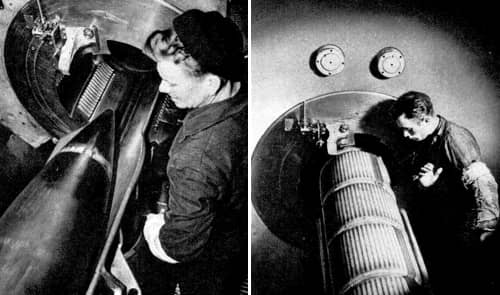
Above: A shell being loaded into a naval gun (left) followed by powder bags full of explosives (right) used fire the gun. Silk was a favoured casing for powder bags as the fabric completely burned away after the gun was fired, reducing the possibility of a premature explosion when the next charge was loaded.
Women were asked to collect silk and nylon stockings and hand them in to help the war effort.
It is only necessary that in every home, someone conscientiously go through the rag bag and pick out all women’s and misses’ silk and nylon hose, of the following groups:
All silk.
All nylon.
Mixture of silk and nylon.
Mixture of nylon and rayon.
Mixture of silk and cotton.
Mixture of nylon and cotton.
Mixture of silk and rayon. (All rayon stockings not desired.)
All stockings should first be washed and then taken to any hosiery collection depot. Most of these collection centers have been located at women’s and misses’ hosiery counters in department stores, women’s specialty stores, or other stores which retail these items. If you cannot take them yourself, ask someone in your neighborhood to pick them up for you.(Wambsganss, 1943, p.19)
Although nylon and silk stockings were scarce, American women were not badly off as they still had access to good supplies of rayon and cotton stockings.
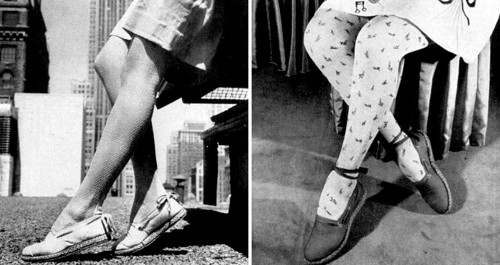
Above: 1943 Cotton stockings as sold in the United States.
Across the Atlantic, where supplies were more limited and clothing rationing more extreme, the stocking situation was much worse. Women in England were issued with 60 clothes coupons per year and a pair of stockings took two of those plus cash.
As silk and nylon stockings vanished from the shelves, women looked to alternatives. Depending on the occasion, what was available, their degree of patriotism, and their economic situation, they substituted with stockings made from other fibres, wore socks, covered their legs with trousers, went bare-legged or used leg make-up – also known as cosmetic stockings, liquid stockings, bottled stockings and phantom hose.

Above: 1941 English Vogue looks at the stocking shortage and suggests possible alternatives.
Some cosmetic companies had been making leg make-up well before the war to give legs the appearance of a tan, e.g., Dorothy Gray’s Finishing Lotion (1929), Peggy Sage’s Sham-Tan (1933), and Elizabeth Arden’s Velva Beauty Film (1933). Most were variations of the liquid or cream powders used to even out skin tones on arms, legs and other exposed parts of the body.
See also: Liquid Face Powders
Some products were made specifically as a stocking substitute, such as Doraldina Leg Make-up released by the Doraldina Company in 1927. The description below is of an unnamed ‘hosiery cream’ sold in London in 1929.
Canned hosiery is the latest solution to the bare-leg problem which is now exciting fashionable London. A leading store in the British metropolis is now selling in its toilet goods section a thick, smooth cream which, when spread evenly and generously all over the leg, from ankle to well above the knee, has all the appearance of beautiful silk stockings. It does not crack, it does not irritate the skin (in fact, it prevents sunburn), and it does not rub off until removed with the aid of warm water and soap.
This new “hosiery cream” is sold in large collapsible tubes and in bottles. It is available in many of the latest and most popular silk stocking shades. Women can choose a shade between the palest beige and dark ochre shades. Actresses are using these bottled stockings considerably, so are girls on seaside vacations, and it requires the very closest and repeated inspection to reveal the fact that the limbs are not clothed in the orthodox manner.(AP&EOR, 1929)
The idea of cosmetic stockings gained support during the war and a large number of cosmetic companies added them to their inventory. The list includes: Leg Make-up (Charles of the Ritz), Jiff-On (Beauty Counselor), Stockingless Cream (Cyclax), Stocking Lotion (Harriet Hubbard Ayer), Summer Stockings (Jaquet), Leg Make-up Film (Frances Denney), Leg Show (Dorothy Gray), Liquid Stockings (Henry C. Miner), Wondersheer (Bellin), Gentlemen Prefer Bronze (Charbert), Stockings Out of the Bottle (Products Nina), Mauvis Liquid Hose (V. Vivaudou), Du Barry Leg Make-up (Richard Hudnut), Duration Leg-Do (Lehn & Fink), Leg Silk (Revlon), Leg Make-up (Jacqueline Cochran), Mist of Dawn (Kathleen Mary Quinlan), Soft-Focus Leg Make-up (Lenthéric), Chiffon Liquid Hosiery (Primrose House), and Leg Stick (Helena Rubinstein). As might be expected, the United States had the widest range.
Leg make-up sales were low in the early part of the war but picked up as manufacturers improved their products and their sales techniques, and women got more desperate. Even so, sales never met early expectations, mainly due to the poor quality of the products. It was very difficult to produce a fluid product that did not separate out in the bottle, dried quickly, and left a water repellent film after it was applied. Many of the brands suffered from pigment separation and only a few were waterproof. Acceptance and repeat business also suffered from the fact that leg make-up took a long time to apply and remove.
Leg make-up bars
In an attempt to drum up sales, some stores ran promotions where you could have your legs painted to see the effect or installed specialist leg make-up bars where you could purchase the cosmetic and get advice on how to apply it for best effect.

Above: 1944 An American department store leg make-up bar. Stocks appear to be plentiful.
Helena Rubinstein was an early American advocate of the leg bar, opening a Bare-Leg Bar in her 5th Avenue salon in 1942. The bar featured leg make-up, special lotions, creams and cosmetics for the legs, a cooling masque for legs and feet, foot talcs and pedicure preparations. On the opening day different types of cosmetic stockings were demonstrated – stick form, out of a bottle, and a version that was sprayed on the legs (AP&EOR, 1942).
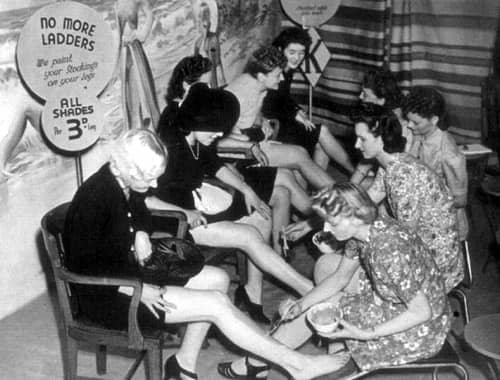
Above: 1941 Women having their legs painted in a British department store during the war.
Leg make-up formulations
Cosmetic stockings came as liquids, lotions, creams and sticks with most women preferring the liquid types. As well as the commercial fit-for-purpose products, women also used other cosmetics they had on hand, such as Pan-Cake make-up and face or suntan powders applied over cold or vanishing cream.
A good cosmetic stocking had a colour and texture that resembled women’s hosiery, went on smoothly and evenly without streaks, dried quickly, adhered to the skin and stayed on when wet or rubbed against clothing but could be washed off with soap and water. The ingredients used included: zinc oxide and titanium dioxide to give covering power; iron oxides, lakes and dyes to provide colour; talc to simulate the sheen of a stocking; humectants such as glycerine or sorbitol to reduce flaking; an adhesive agent such as methyl cellulose, casein or latex to help the mixture stick to the legs; and alcohol to quicken drying. Some forms contained dyes but many did not.
Water constitutes the major proportion of the suspending medium. It should be modified by the addition of a certain amount of alcohol to promote more rapid drying. Furthermore, a certain amount of glycerin or other humectant should be present to act as a plasticizer and help to prevent the powder from flaking off the legs. A useful addition to the liquid should be a small proportion, differing according to the material used, of a wetting or spreading agent. This promotes a more uniform spread of the solution on the skin surface. Too much is not desirable, since the liquid may later lather excessively. A product formulated along these lines will still not adhere so well that it cannot be rubbed off by contact with the skirt hem, and a fixative should be of some value. The addition of a gum, natural or synthetic, is valuable in promoting adhesion and may even serve to modify texture in a desired manner. Here again the gum should be used judiciously, excessive amounts thickening the mixture unduly, and preventing uniform spread and quick drying.
(Jannaway as quoted in Wells & Lubowe, 1964, p. 310)
Some sample recipes are given below.
Liquid cosmetic stocking % Precipitated chalk 10.0 Talc 5.0 Titanium dioxide 3.0 Bentonite 2.0 Alcohol 8.0 Glycerin 3.0 Wetting agent 0.5 Methyl cellulose 0.5 Water 68.0 Dye and pigment q.s. 100.0 (Thomssen, 1947, p. 76)
% Zinc oxide 6.0 Chalk (precipitated) 16.0 Methylcellulose 0.5 Glycerin 16.0 Water 61.5 Colouring matter, preservative, perfume q.s. (Wilkinson & Moore, 1982, p. 309)
A leg make-up cream could be made by adding the colours to a cream base in which some oil has been added to give luster. Stick forms, made with a wax-oil mixture would not need additional oils.
Stick cosmetic stocking % Petrolatum 45.0 Ozokerite 15.0 Soft amorphous wax 10.0 Deodorized cocoa butter 5.0 Titanium dioxide 20.0 Color 5.0 100.0 (Thomssen, 1947, p. 79)
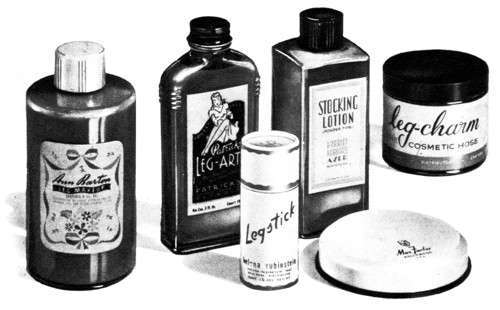
Above: A range of American leg make-up including: Ann Barton’s Leg Make-up, Harriet Hubbard Ayer’s Stocking Lotion, Patrick’s Leg Art, Cosmetic House’s Leg Charm, Helena Rubinstein’s Leg Stick and Max Factor’s Pan-Cake Make-up.
Making their own
In England, wartime austerity led some women to try their hand at making their own cosmetic stockings from published recipes. Some, like the one below, were liquid powders:
Talc 20 Kaolin 75 Lakes or pigments 5 100 The liquid will, of course, consist principally of water, but something must be added to assist spreading properties, to help to hold the powder on and perhaps to hasten evaporation. … Such substances as glyceryl mono-stearate (Tegin or Abracol G.M.S.) or “diglycol laurate” are useful additions. … The following is a formula for a really cheap emulsion which is nevertheless satisfactory for this purpose, and is easy to make provided some kind of homogenizer or emulsifier is available.
Suphonated castor oil 20 Liquid paraffin (technical) 36 Water to 100 No heating is required. Mix the two oils. Stir in the water and pass through an emulsifier.
The preparation of a liquid leg make-up along these lines would resolve itself into the following stages—
Preparing the powder content—mixing, grinding, or sifting.
Diffusing the glyceryl mono-stearate or other similar substance in a portion of the water.
Mixing these two portions together with sufficient water to produce a creamy liquid.
Preparing the emulsion.
Adding this to the previously mixed ingredients with light stirring, and finally adding perfume, which may be dissolved in a little alcohol and making up to the desired weight or volume.(Bushby, 1947, pp. 150-151)
Using cosmetic stockings
Having obtained a jar, bottle or stick of cosmetic stocking, women soon discovered that there were a number of obstacles to overcome to achieve the illusion of stockings.
Before applying the make-up, leg hair had to be removed, most commonly by shaving or abrading the leg with a mitt. Some beauty experts suggested that leg hair be permanently removed by diathermy (thermolysis) or electrolysis. Loose skin on the legs and feet also had to be rubbed off to avoid it flaking off and leaving behind light patches.
See also: Hair Removers
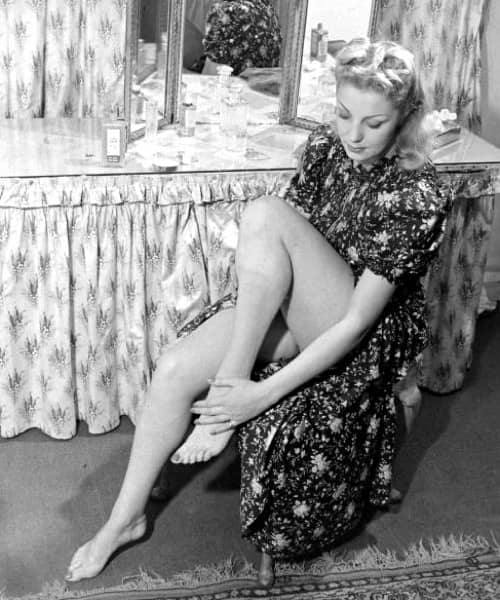
Above: 1941 Applying cosmetic stockings.
Applying the cosmetic stocking liquid, lotion, cream or stick evenly so that there were no streaks also took practice. Fortunately, help on how to achieve the best results was available from the place of purchase and from articles in newspapers and magazines.
Above: 1940 Painted Stockings. The model is using Cyclax Stockingless Cream introduced in 1940.
You may think you give your legs pretty good care. You see that they get a good lathering when you have your evening bath. You dry with care. But just try smoothing on one of the liquid preparations for leg make-up! It may start on smoothly and evenly, but next thing you know little specks of dead cuticle will rub off, leaving streaks behind!
Use a Brush
Heels, insteps and toes are even worse, because skin is thicker and more likely to be calloused. The calluses may be such small ones that you aren’t even aware of them, but once you start rubbing, up they come to your embarrassment and chagrin.
Feet and legs need scrubbing nightly with a brush and soapsuds with an extra workout around the backs of the heels, ankles, insteps and across the tops of the toes. Rinse off and use a rough towel for drying, rubbing briskly over the points named as well as up and down the legs to remove every flake of dead skin. Finish by smoothing the legs with body lotion, hand lotion or that odd bit of cold cream you want to get rid of. It won’t take much of this regular routine to turn out limbs you can be proud of, with make-up or without it.
There are three main types of leg make-up: the dark tinted liquids that you apply with cotton, the lotion and cream type that you apply with your hand and the solid stick variety that you stroke on directly. Whichever you prefer, there is a trick to applying it for best results. Experiment with different shades until you find the one that is most flattering, then practice putting it on until you can do it easily.
The creamy and lotion types are easiest for me to apply, although I must warn you to be careful about overlapping. Have the legs slightly moist: immediately after your shower is a good time to put on your liquid stockings. Pour a bit of the lotion into the palm of one hand and use the fingers of the opposite hand to dip and transfer it to the leg. Apply from the knee or just above it down to the tips of the toes. Work in one direction and be sure to cover all the leg surfaces. Give the application time to dry, then take a clean cloth or old silk stocking and go over the leg. This removes any powdery excess and erases streaks if any.Long Even Strokes
If the heavier stick make-up is your choice, first smooth the legs with a bit of cream or body lotion and wipe of the excess. Then apply the make-up from the stick in long even strokes, putting it on as evenly as possible to start with. Then use the palms of the hands to smooth any overlaps and wipe off the excess. After the surplus cream is removed, dust lightly with tinted bath powder. This keeps down any stickiness that might smudge the hem of your dress and gives a mat-like finish that really looks like stockings.
The transparent tinted liquids are applied with cotton wool in long upward or downward strokes and blended while still moist. One of these liquids in a shade called bittersweet can give almost any effect. A single application looks like pale, sheer evening stockings: two or three coats give a deeper suntanned look for daytime wear.(Hunt, 1942)
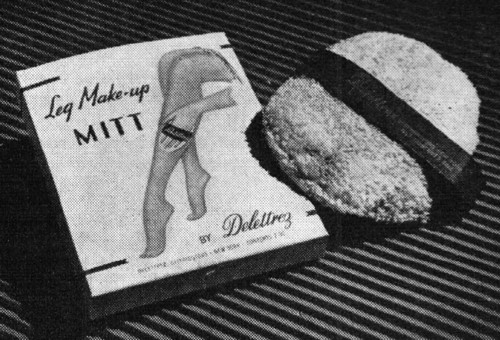
1944 Delettrez Leg Make-up Mitt. A leg make-up and applicator combined. It was applied by wetting the mitt then stroking the make-up on. Shades: Beige, a light tone; Nut-Meg, a medium shade; and Topaz, a darker bronze shade.
Completing the illusion
Those women who wanted the produce the illusion of wearing real stockings as closely as possible could do two other things. First, real stockings had a noticeable sheen. To mimic this, some cosmetic stocking mixes could be buffed up after application to make them shine. Elizabeth Arden sold her Velva Leg Film Buffer for precisely this purpose. Second, stockings of the day had obvious heels and leg seams which could be imitated by drawing them on with an eyebrow pencil or something similar. However, drawing a straight line of even thickness down the back of the leg required a steady hand and a good deal of skill. Clearly, not everyone went to this trouble and many women simply applied the cosmetic stocking and left it at that.
Nylon stockings return
The end of the war saw nylon stockings return to the shelves followed by a corresponding decline in the use of substitutes. DuPont began producing nylon for stockings within two-weeks of the Japanese surrender and this produced what American reporters of the time called the ‘nylon riots’ of 1945 and 1946 (Meikle, 1995) as women scrambled to buy them in the United States.

1946 Manufacturing nylons in Nottingham, England.
In those parts of the world where things remained economically depressed and/or clothes continued to be rationed, cosmetic stockings lingered longer and were still being sold in the 1950s, well after the war was over.
The widespread disappearance of cosmetic stockings was not the end of leg make-up, as it was still used by some women to make their legs look tanned and new entrants occasionally appeared on the market well after 1950, Coty’s Ultra Legs being a good example.
However, the true beneficiary of all the research that went into improving the formulation of cosmetic stockings was not leg make-up but rather the new make-up bases and foundations developed in the 1940s and 1950s that went on change the way post-war women wore face make-up.
First Posted: 2nd January 2012
Last Update: 27th August 2024
Sources
The American perfumer & essential oil review. (1929). New York: Robbins Perfumer Co.
The American perfumer & essential oil review. (1942). New York: Robbins Perfumer Co.
Bushby, R. (1947). Cosmetics and how to make them (3rd ed.). London: Pitman.
Hunt, J. (1942, September 1). There’s an art to applying that liquid leg make-up. The Daily News. London.
Kay, G. (2005). Dying to be beautiful: The fight for safe cosmetics. Columbus, Ohio: Ohio State University Press.
Meikle, J. L. (1995). American plastic: A cultural history. New Brunswick, NJ: Rutgers University Press.
Thomssen, B. S. (1947). Modern cosmetics (3rd ed.). New York: Drug & Cosmetic Industry.
Wambsganss, M. (1943). Weave no more silks. Domestic commerce and weekly bulletin of the national war economy. 31(7), 19.
Wells, F. V., & Lubowe, I. I. (1964). Cosmetics and the skin. New York: Reinhold Publishing Corporation.
Wilkinson, J. B., & Moore, R. J. (Eds.). (1982). Harry’s cosmeticology (7th ed.). New York: Chemical Publishing.
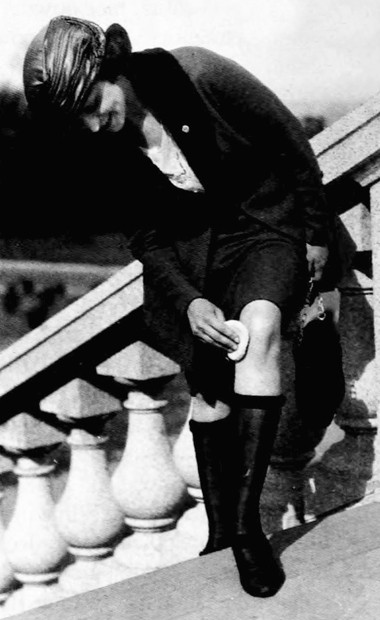
1921 A ‘flapper’ powdering her legs. A lot more leg was exposed in this period, particularly on the beach and some cosmetic companies developed leg make-up that was a better solution than powder.
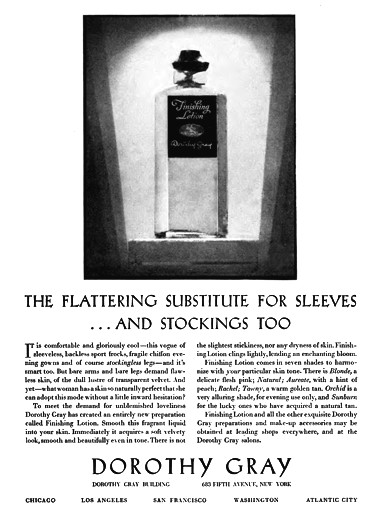
1929 Dorothy Gray Finishing Lotion. It came in seven shades: Blonde, Natural, Aureate, Rachel, Tawny, Orchid and Sunburn.

1934 Elizabeth Arden Leg Make-up.
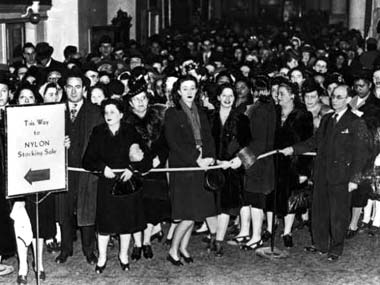
1940 Nylon stockings become widely available in the United States in 1940 and DuPont had difficulty in meeting the demand.

Collection box for silk and nylon stockings in an American department store during the war. The donor is wearing socks, another alternative to stockings.

1940 Applying leg make-up. Drawing an even, straight line down the back of the leg was the most difficult part. Note the two different types of leg make-up on view as well as Pan-Cake.

1942 Using a device like this would help produce a better stocking line.
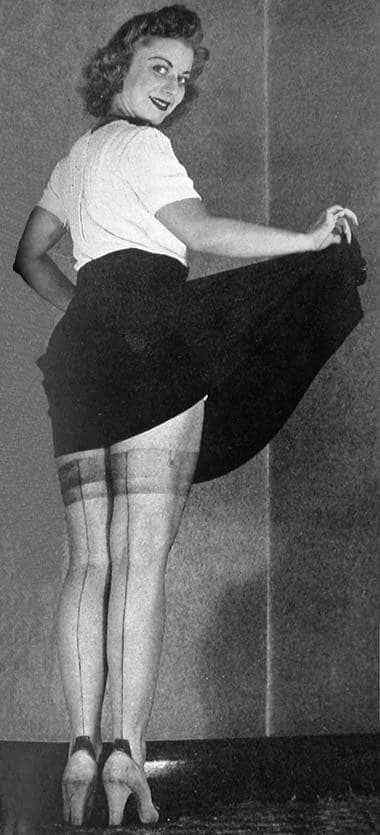
1942 A fabulous example of the cosmetic stocking craft (AP&EOR, 1942).

1942 Miner’s Liquid Make-up.
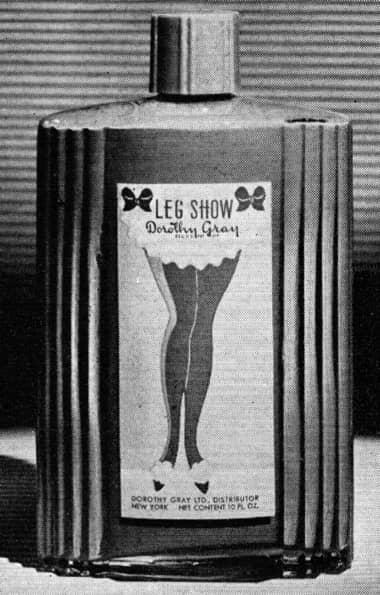
1942 Dorothy Gray Leg Show.

1943 Bonnie Bell Mexitan.
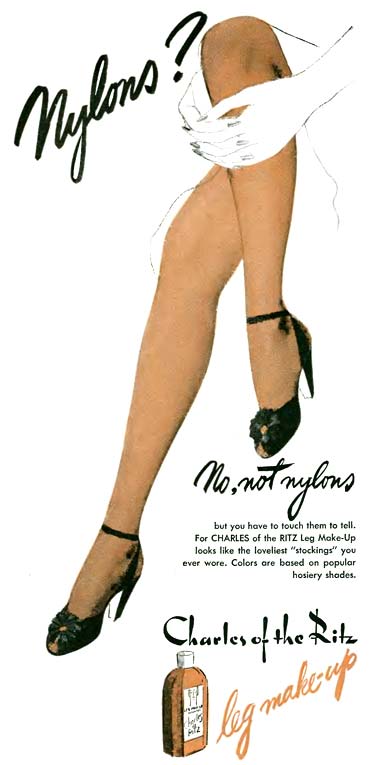
1943 Charles of the Ritz Leg Make-up.

1943 Schiaparelli Shocking Stocking.

1943 Armand Leg Make-up.
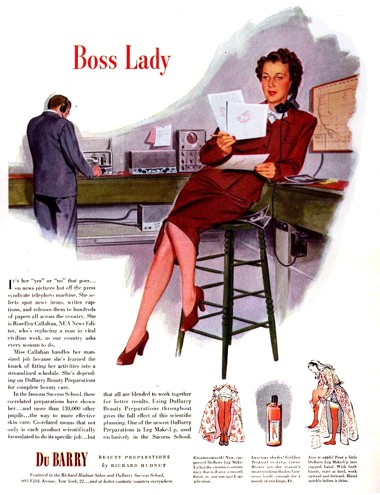
1944 Richard Hudnut Du Barry Leg Make-up.
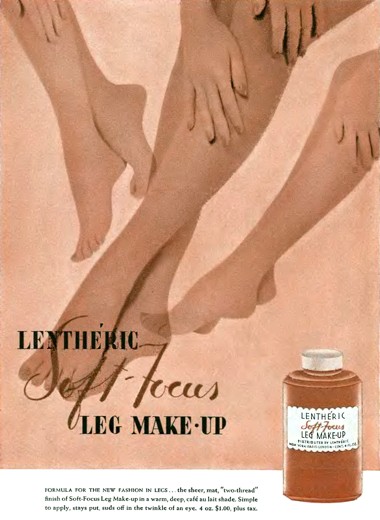
1944 Lenthéric Soft Focus leg make-up.
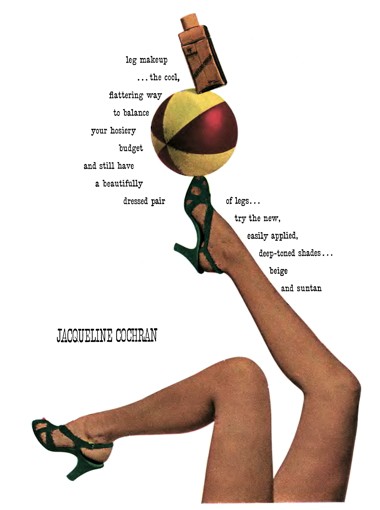
1944 Jacqueline Cochran Leg Make-up.
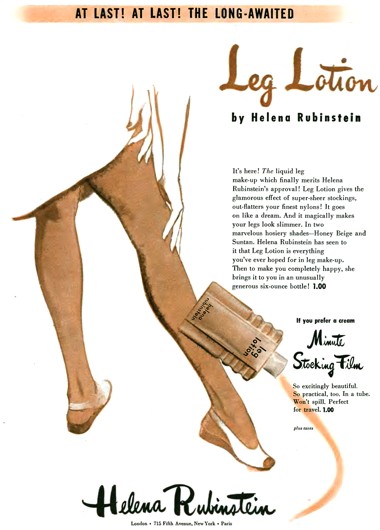
1946 Helena Rubinstein Leg Lotion.
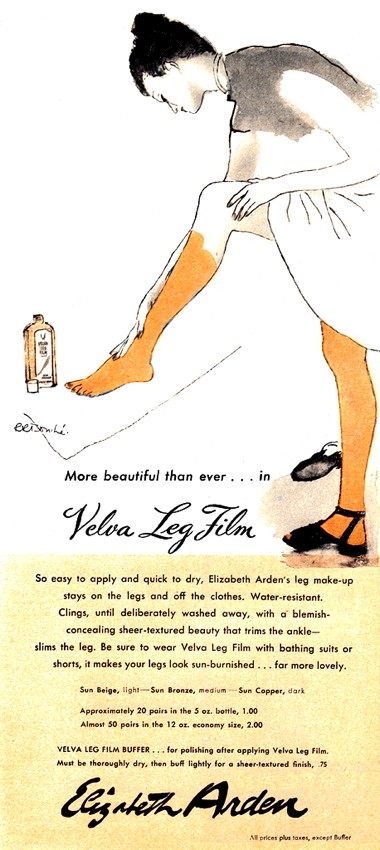
1946 Elizabeth Arden Velva Leg Film. Introduced in 1941, Arden continued to promote it after 1945.
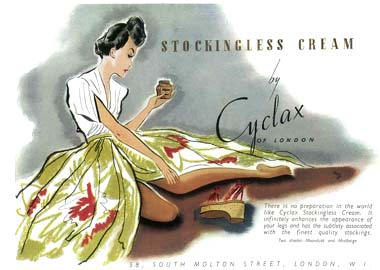
1948 Cyclax Stockingless Cream.
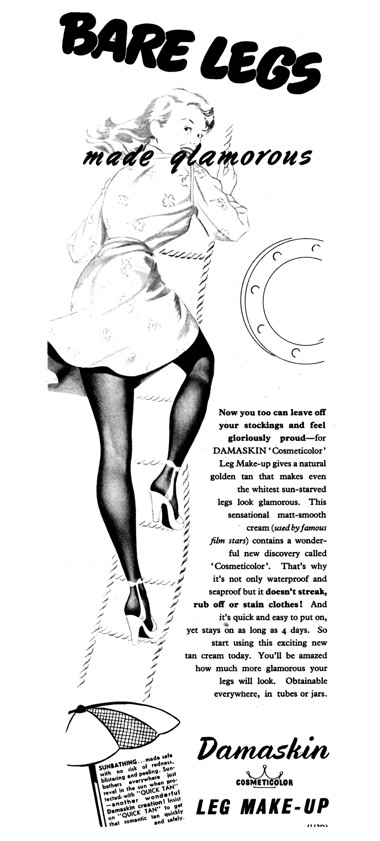
1951 Damarskin.

1968 Helena Rubinstein Nude leg and body make-up.
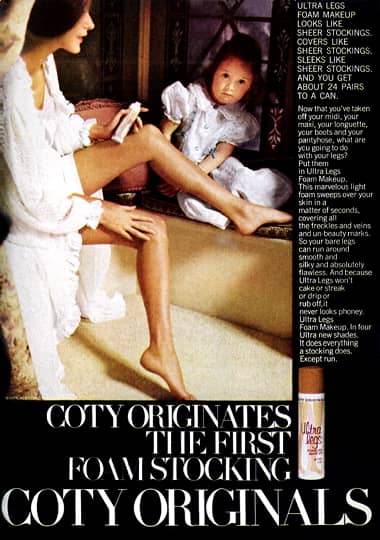
1971 Coty Ultra Legs.
